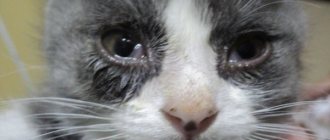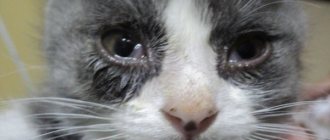(Be the first to vote!)
5589564
07/01/2021 owner reviews
Lately, you've been noticing that your furry friend tends to slide his butt along the floor, which is an iconic dog behavior. Given the erratic nature of cats, you might at first think that your pet is just playing to kill time. However, upon closer inspection, cats often leave behind a brown discharge.
The liquids emit a rather unpleasant odor, leading you to believe that your pet has a serious problem. So, what should pet owners do if they are faced with the problem of brown discharge?
If you are concerned about your pet's health and want to know what is going on, this article is for you. Below, you'll find everything cat parents need to know about the problem of brown poop, from causes to treatment.
Generally speaking, the cat's anal area is vulnerable to a variety of diseases, so pet owners should pay attention to this area. As soon as you notice anything strange, it is extremely important to take your cat to a reputable veterinary clinic for a thorough examination.
- Causes of discharge
- Symptoms of anal sac diseases
- Diagnostics
- What to do
Causes of discharge
Overall, when it comes to the problem of "cat leaking brown fluid", there are several suspects, but anal sac disease is at the top of the list.
FYI: If you lift a cat's tail, you will see two anal glands located slightly below the anus on either side. Because the glands are embedded in muscles, they are difficult to see from afar. In either case, the role of the anal glands is to secrete a yellow-brown fluid when the cat defecates. As you might expect, the smell of liquids is far from pleasant, but cats rely on liquids to mark their territory.
© shutterstock
Usually, a cat's anal glands work as intended, but sometimes something can cause them to produce a thicker-than-normal fluid. Because the pores on the glands cannot drain fluid sufficiently, the glands become larger and larger. After some time, cats will understand what is happening and will try to manually get rid of the fluid in the glands by licking, tugging, ...
If pets can successfully empty their congested anal glands, then everything is fine. On the other hand, if pets can't do anything on their own, people need to step in.
What happens if an owner ignores their cat's plight? Well, pets suffering from anal sac disorder experience severe discomfort that is a direct result of the strange activity of the anal glands. Moreover, when affected cats lick their butts over and over again to cause discharge, they introduce bacteria from their mouth to the area. This means that the risk of urinary tract infection increases dramatically. Finally, the glands may one day burst, causing severe pain, infection and possibly death.
White vaginal discharge from a cat
The appearance of white discharge from the vaginal area and loop in a cat is provoked by factors of both physiological and pathological nature. Normal discharge includes white discharge during heat and pregnancy.
During estrus, initially clear mucus is released from the cat's loop, which subsequently becomes white and has no specific odor. In addition to discharge, the period of onset of estrus in a cat is characterized by a number of symptoms - the animal arches its back, actively calls for the opposite sex, and shows anxiety.
White vaginal discharge from a cat may appear during the last stages of pregnancy. The secreted secretion is mucous and whitish in color, which is associated with the release of the plug that covers the cervix during pregnancy.
Pathological processes developing in the reproductive system of females, in the first stages, can also be characterized by the appearance of whitish discharge. The main diseases identified in veterinary medicine in cats are:
- Vaginitis - characterized by the appearance of white exudate, indicating the development of an inflammatory process. Streptococcal and staphylococcal infections can provoke the development of vaginitis in a pet.
- Endometritis is a disease localized in the area of the uterine walls. At the development stage, endometritis is characterized by the appearance of copious mucous-type discharge, which later acquires a whitish tint. They are thick and have a strong, unpleasant odor. But the following options are associated with pathological processes.
- Pyometra is a dangerous disease that often affects unsterilized females. The owner can notice changes in the cat’s behavior at home, paying attention not only to the appearance of white vaginal discharge, but also to the symptoms accompanying the development of pyometra, such as a frequent urge to urinate, a tense and swollen abdomen. The appearance of discharge during the development of purulent inflammation in the uterine cavity is characteristic of the open form of the pathology. The closed form of pyometra is not characterized by the appearance of any discharge. Quite often, pyometra develops against the background of untimely treated endometritis. The danger of the pathology lies in the fact that the animal is at risk of peritonitis, blood poisoning, which ends in death in the absence of surgical intervention.
White discharge in the loop area can be caused by uncontrolled use of contraceptive hormonal drugs. Ignorant owners purchase drugs to regulate sexual heat in cats, without thinking about the consequences for the animal’s body. In addition to endometritis and pyometra, the female may develop malignant tumors in the uterus or appendages.
In order to prevent the development of life-threatening diseases, veterinary experts recommend routine sterilization of all females that are not planned for breeding.
Symptoms of anal sac diseases
Once you understand the nature of anal sac diseases, you can easily monitor the symptoms. Because overcrowded glands cause irritation, cats will lick, run, and perform all sorts of tricks to remove fluid from the inside. In extreme cases, cats may resort to scratching and biting for a purpose that is dangerous.
Since a cat's anal glands are only supposed to secrete fluid during bowel movements, any other type of discharge is a problem. Therefore, if you see traces of brown fluid, your pet has an anal sac disorder.
Associated symptoms
Basically, various discharges are accompanied by other symptoms that accompany pathologies.
Among these symptoms
:
- itching and burning in the anus;
- blood in stool;
- pain in the anus or intestines;
- defecation disorders;
- weakness.
Specific symptoms of a particular pathology, combined with complaints about discharge, allow the doctor to make a primary diagnosis and prescribe additional diagnostic tests.
Diagnostics
You cannot solve the problem of “brown cat discharge” on your own, so take your pet to a qualified veterinarian. After a couple of questions, your veterinarian will perform a physical test by gently pressing on your pet's glands. Healthy glands should secrete thin yellow fluids, while enlarged glands should secrete thick brown fluids. It is worth noting that you should inform the veterinarian about your pet's condition before admission, such as diarrhea, soft stools,... To rule out other diseases, determine the exact cause and develop an appropriate treatment regimen, the veterinarian will perform chemical testing, including urinalysis, electrolyte analysis, blood test...
© shutterstock
What fluid is coming from my cat's anus??
While we must be vigilant in caring for our cat's health, it is important to recognize the symptoms of the condition and what may be a relatively common occurrence. This is why we need to observe the different types of fluid that may be coming out of your cat's rear end. Here are some of the possible colors, along with their likely source:
- Brown Fluid If your cat has brown fluid from the rectum, it is likely due to diarrhea. The causes of diarrhea vary, but most cases are related to diet. Since this is a symptom of many other conditions, it is important that you take them to the vet if it lasts more than 24-48 hours...
- Yellow Liquid Yellow liquid can also be part of diarrhea, but it can also be a sign that the cat has eaten something that has changed that color. However, if it is clear with a yellowish tint, it may be from the anal glands instead of the anus itself.
- Clear Fluid If you see clear fluid coming out of your cat's anus, it is likely due to your anal glands. If your cat is a little under the weather, then you may have some clear mucus coming from the anus. However, it could also be a sign of something more problematic, such as parasites, bacterial overgrowth, colitis, or even tumors, so you should contact your vet.
- Red Liquid If you see blood coming out of your cat's anus, then you should know that there are two main types. If it is bright red, then it is fresh blood and is likely coming from the anus itself. If it is dark red or brown, then it is overcooked and means that something is wrong in the gastrointestinal tract.
Prevention is always better than cure, so if you see a problem, you should take your cat to the vet for an evaluation. If they think it's a symptom of something more serious, they can run the appropriate tests...
What to do
- Swollen glands
In cats with swollen glands, veterinarians first drain fluid with a syringe, clean out the glands, and then administer antibiotics to treat infections. In most cases, your pet can go away after this, but if your cat has chronic swelling, surgical removal of the glands is highly recommended.
In case your cat has strange openings in the anal sac, veterinarians may be able to formulate a treatment regimen based on cyclosporine. Simply put, cyclosporine prevents bacterial infections and is taken orally.
Reminder : Cyclosporine is known to weaken the immune system and, as a result, long-term use of this drug is not recommended. In most cases, it is better to remove the pet's glands instead of controlling the tumor with cyclosporine. Spaying your pet is also a good idea to limit the activity of the anal glands and reduce the frequency of episodes of swelling.
- Torn glands
At this point there is nothing left to do but perform emergency surgery, the vets will remove whatever is left of the glands and clean the area. If the entire operation goes smoothly, the risk of infection should be minimal and a recovery phase will follow. For 1-2 weeks you will need to give your pet an antibiotic prescribed by your veterinarian, but that's it, your pet will be back to his normal self before you know it. As always, return to the clinic periodically to have stitches, staples, etc. removed.
The main types of pathological discharge from the eyes
Pathological discharge from the eyes, depending on the cause, may differ in color and consistency:
- Liquid transparent discharge (involuntary lacrimation) indicates that there is no bacterial infection yet. They are most often a symptom of an allergic reaction.
- The next stage is a white substance of mucous consistency, secreted at the initial stage of viral infection of the eyelids or conjunctiva. Timely treatment will help eliminate unpleasant symptoms.
- Yellow or greenish discharge indicates the appearance of pus. This is how a bacterial infection of the eye structures manifests itself. The general condition of animals often worsens - the temperature rises, appetite disappears, and intoxication of the body develops.
- Brown, thick discharge from the eyes of cats indicates that they contain a certain amount of erythrocytes - red blood cells. The color of the discharge is due to several factors: impaired outflow of tear fluid (the reasons may be different), acute infectious inflammation of the ocular structures, affecting the choroid of the eyes.
Is this anal fluid?
If you see your cat losing fluid from the anal area, it is likely due to one of the above reasons. However, you must be very careful to correctly identify the source. In the case of women, we must ensure that the secretion comes from the anus and not from the vulva. If there is discharge that is pink, bloody, or contains pus, then it may be a reproductive problem. If your cat has not been spayed, she may be pregnant. However, such discharge can also be a sign of infection of the uterus or piometra . In any case, you should seek veterinary help immediately to determine the problem and find a course of treatment...
This article is purely informational. HowMeow.ru does not have the right to prescribe veterinary treatment or diagnose. We invite you to take your pet to the vet if you are suffering from any illness or pain.
How to treat pathology?
When brown, pink or white discharge appears in a cat due to natural causes, no special treatment is prescribed. If the owner does not intend to breed offspring, it is better to sterilize the pet. In a castrated cat, such problems disappear on their own. It’s another matter when blood flows from the genitals due to the progression of a dangerous disease. A treatment regimen that includes the following groups of drugs will help stop the disease:
An examination will help to cope with the situation, on the basis of which drug treatment will be prescribed.
- Hemostatic. Prescribed only by a doctor, they are used in cases where bleeding occurs without stopping due to a violation of the hematopoietic process.
- Antibiotics. They are used when there is pus with pathological ichor in the vaginal discharge, which indicates the addition of a bacterial infection.
Sometimes, with heavy bleeding, conservative therapy is powerless. Then the doctor decides to treat the pathology surgically. During surgery, defects that bleed are eliminated, as well as affected internal organs, including the uterus, are removed. After the operation, rehabilitation is carried out. Fluid may still be released from the genitals, so the animal must be under the supervision of a doctor who strictly monitors how recovery is progressing.
How to express a cat's anal gland
If you see that your cat is licking her anal area a lot and is unable to release anal discharge properly, you may need to evaluate the gland yourself. However, although you may need to manually express the glands, it is best to go to the vet the first time so they can both show you how to do it correctly and make sure your cat is exposed to best practices first. This will help you express your cat's anal glands more easily.
Ideally, you will want someone to help hold the cat while her anal gland expresses. This is because it can be a very uncomfortable and even painful procedure. Once you have someone restraining the cat, you should lift the tail and look for the glands. For this procedure, it is better to wear rubber or latex gloves. Using your thumb and forefinger, grasp the individual gland and squeeze it towards the anus, where fluid usually comes out. You may want to leave the newspaper as the smell of the secretion can be quite unpleasant. The anal gland secretion should be brown, so if it is not, you should talk to your veterinarian.
How dangerous is this?
Many owners believe that spotting in cats occurs due to pathologies of the urinary system. Indeed, the symptom may indicate inflammation or the formation of stones. Such diseases often lead to death. Therefore, if illness appears, it is important to show the animal to a veterinarian as quickly as possible. Often, spotting in cats occurs due to an improper diet.
A lack of iron and other important substances in food negatively affects the pet’s well-being, leading to deterioration and metabolic disorders. However, there are cases when such a symptom is the result of natural changes occurring in the animal's body. But this does not mean that you need to independently draw conclusions about the reason for its appearance. To establish the correct diagnosis, you must consult a veterinarian.











